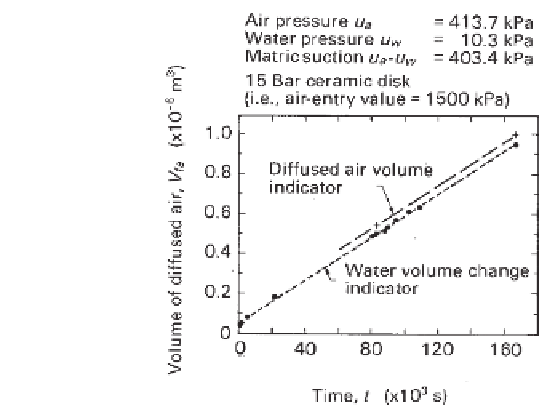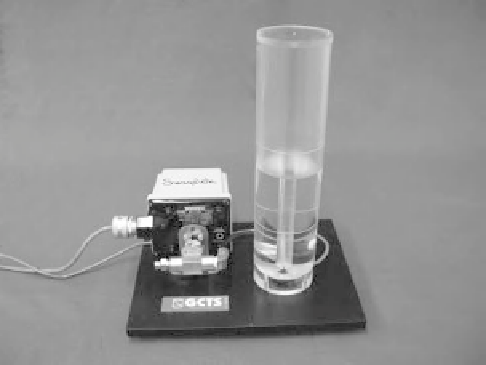Environmental Engineering Reference
In-Depth Information
The 5-bar disks showed that there was about 0
.
15 cm
3
of
diffused air that collected in the compartment below the high-
air-entry disk each day as the applied air pressure approached
500 kPa. The 15-bar disks showed that there was more than
2
.
0cm
3
of diffused air per day as the applied air pressure
approached 1500 kPa. Laboratory tests on unsaturated soils
often run for many days and even weeks, and as a result it is
important that diffused air volumes be measured and used to
correct water volume changes in the soil specimen.
9.9 INDIRECT ESTIMATION OF AIR FLOW
PROPERTIES
The SWCC can be used for the indirect estimation of the air
permeability function. The air permeability function provides
a relationship between the air coefficient of permeability and
either soil suction or the air content of the soil. The minimum
air permeability occurs as the soil approaches saturation. The
assumption is made that air can only diffuse through the water
phase at a rate defined by the diffusivity of air through water
and the tortuosity of the water paths around the soil particles.
The soil will have themaximumcoefficient of air permeability
when the soil is completely dry and soil suction is approaching
a value of 10
6
kPa. The concept of intrinsic permeability can
be used to relate the saturated hydraulic conductivity of a soil
to its maximum coefficient of air permeability.
Figure 9.21
Measurement of steady-state diffusion of air through
saturated ceramic disk using water volume change indicator and
diffused air volume indicator (from Fredlund, 1973a).
The air diffusion test was performed on a saturated, 15-bar
ceramic disk (i.e., 1500 kPa air-entry value). Both the water
volume change indicator and the diffused air volume indi-
cators recorded essentially the same volumes of diffused air
over a period of 2 days. The straight lines indicate steady-
state diffusion of air through water in the high-air-entry disk.
Figure 9.22 shows an automated diffused air volume indi-
cator developed by GCTS. The device can be set to automat-
ically flush the compartment below the high-air-entry disk
of a triaxial cell at prescribed time intervals. The appropri-
ate valves are closed and diffused air is flushed from below
the high-air-entry disks at predetermined times. Measured
results of air diffusion through 5- and 15-bar ceramic disks
are shown in Figs. 9.23 and 9.24.
The diffusion of air through the high-air-entry disks appears
to accelerate as the air-entry value of the disk is approached.
9.9.1 Soil-Air Characteristic Curve
The concept of a soil-air characteristic curve (SACC), can
be used to describe the relationship between the volume of
air in the soil (i.e., volumetric air content) and soil suction.
The volumetric air content can also be referred to as the air
degree of saturation. The SACC can be used to compute the
air permeability function (Ba-Te et al., 2005). The amount of
air in the voids can be written as the air degree of saturation
S
a
(ψ)
, which is related to the water degree of saturation:
S
a
(ψ)
=
1
.
0
−
S(ψ)
(9.79)
where:
ψ
=
soil suction and
S
=
degree of water saturation.
The degree of saturation is expressed in decimal form in
Eq. 9.79. The amount of air in the soil can also be written
as a percentage of the total volume of the soil sample and
the volumetric water content:
e
θ
a
(ψ)
=
e
−
θ(ψ)
(9.80)
1
+
where:
θ
a
=
volumetric air content,
θ
=
volumetric water content, and
Figure 9.22
Automated diffused air volume indicator developed
by GCTS. (Photo courtesy of GCTS, Tempe, AZ.)
e
=
void ratio.











Search WWH ::

Custom Search